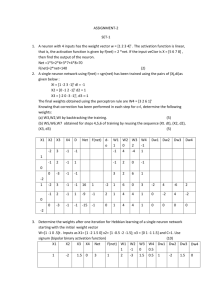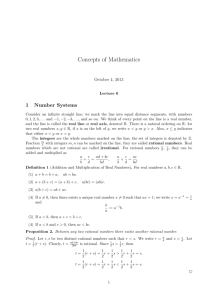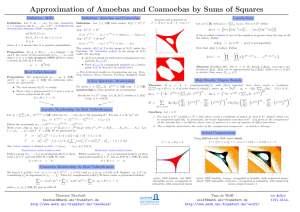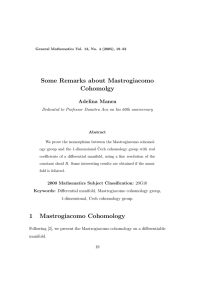NOTE ON THE RATIONAL COHOMOLOGY
advertisement
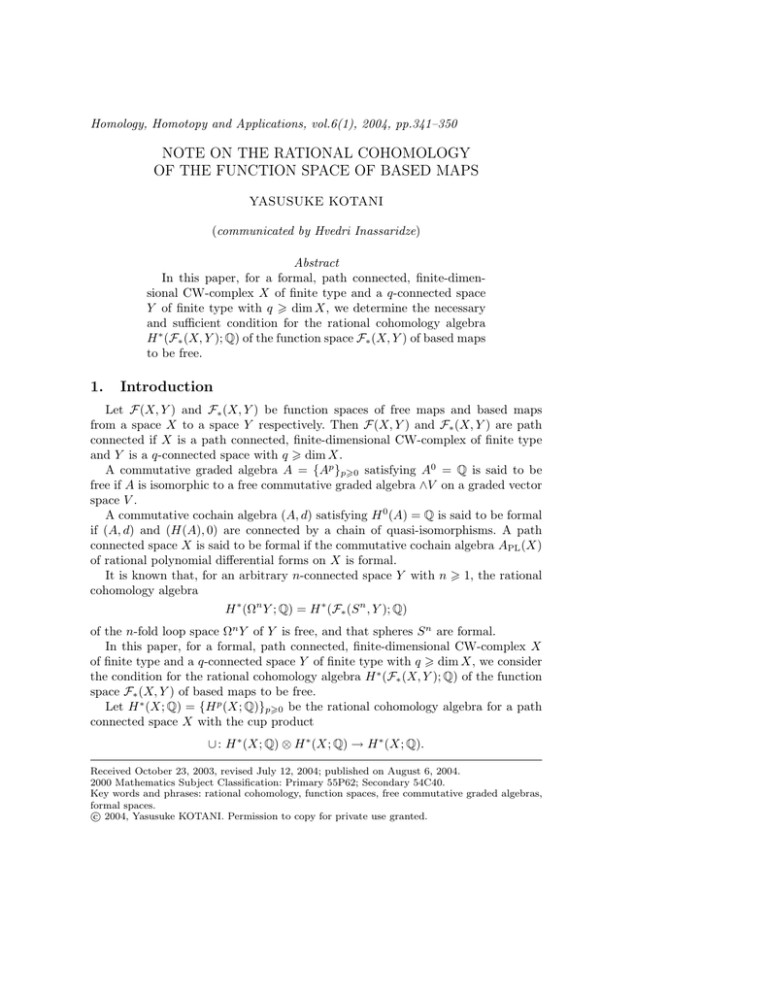
Homology, Homotopy and Applications, vol.6(1), 2004, pp.341–350
NOTE ON THE RATIONAL COHOMOLOGY
OF THE FUNCTION SPACE OF BASED MAPS
YASUSUKE KOTANI
(communicated by Hvedri Inassaridze)
Abstract
In this paper, for a formal, path connected, finite-dimensional CW-complex X of finite type and a q-connected space
Y of finite type with q > dim X, we determine the necessary
and sufficient condition for the rational cohomology algebra
H ∗ (F∗ (X, Y ); Q) of the function space F∗ (X, Y ) of based maps
to be free.
1.
Introduction
Let F(X, Y ) and F∗ (X, Y ) be function spaces of free maps and based maps
from a space X to a space Y respectively. Then F(X, Y ) and F∗ (X, Y ) are path
connected if X is a path connected, finite-dimensional CW-complex of finite type
and Y is a q-connected space with q > dim X.
A commutative graded algebra A = {Ap }p>0 satisfying A0 = Q is said to be
free if A is isomorphic to a free commutative graded algebra ∧V on a graded vector
space V .
A commutative cochain algebra (A, d) satisfying H 0 (A) = Q is said to be formal
if (A, d) and (H(A), 0) are connected by a chain of quasi-isomorphisms. A path
connected space X is said to be formal if the commutative cochain algebra APL (X)
of rational polynomial differential forms on X is formal.
It is known that, for an arbitrary n-connected space Y with n > 1, the rational
cohomology algebra
H ∗ (Ωn Y ; Q) = H ∗ (F∗ (S n , Y ); Q)
of the n-fold loop space Ωn Y of Y is free, and that spheres S n are formal.
In this paper, for a formal, path connected, finite-dimensional CW-complex X
of finite type and a q-connected space Y of finite type with q > dim X, we consider
the condition for the rational cohomology algebra H ∗ (F∗ (X, Y ); Q) of the function
space F∗ (X, Y ) of based maps to be free.
Let H ∗ (X; Q) = {H p (X; Q)}p>0 be the rational cohomology algebra for a path
connected space X with the cup product
∪ : H ∗ (X; Q) ⊗ H ∗ (X; Q) → H ∗ (X; Q).
Received October 23, 2003, revised July 12, 2004; published on August 6, 2004.
2000 Mathematics Subject Classification: Primary 55P62; Secondary 54C40.
Key words and phrases: rational cohomology, function spaces, free commutative graded algebras,
formal spaces.
c 2004, Yasusuke KOTANI. Permission to copy for private use granted.
°
Homology, Homotopy and Applications, vol. 6(1), 2004
342
Recall that the rational cup length cup(X; Q) of X is defined by
sup{n ∈ Z | f1 ∪ · · · ∪ fn 6= 0 for f1 , . . . , fn ∈ H + (X; Q)},
where H + (X; Q) = {H p (X; Q)}p>0 .
Let (∧V, d) be a Sullivan algebra. Elements in ∧V of the form v1 ∧ · · · ∧ vk for
v1 , . . . , vk ∈ V are said to have word length k. Then the differential d decomposes
uniquely as the sum
d = d0 + d1 + d2 + · · ·
of derivations di raising the word length by i. (cf. [3, Section 12(a)]). Now, we
define the differential length dl(∧V, d) of (∧V, d) by the least integer m such that
dm−1 6= 0. If di = 0 for all i > 0, that is, d = 0, we define dl(∧V, 0) = ∞. We also
define the differential length dl(Y ) of a simply connected space Y of finite type by
that of a minimal Sullivan model for Y . Then we can establish
Theorem 1.1. The differential length of a simply connected space of finite type is
independent of a choice of minimal Sullivan models. Thus it is a rational homotopy
invariant.
Our main theorem is as follows.
Theorem 1.2. Let X be a formal, path connected, finite-dimensional CW-complex
of finite type and Y a q-connected space of finite type with q > dim X. Then
H ∗ (F∗ (X, Y ); Q) is free if and only if cup(X; Q) < dl(Y ).
This paper is organized as follows. In Section 2, we recall the construction of a
minimal Sullivan model for F(X, Y ) due to E. H. Brown, Jr. and R. H. Szczarba [2,
Thoerem 1.9]. Moreover, we describe a minimal Sullivan model for F∗ (X, Y ) is
obtained by that for F(X, Y ) using the evaluation fibration, which is established
by K. Kuribayashi [4, Theorem 3.6]. The proofs of Theorems are given in Section 3
and 4 respectively. In Section 5, we give some examples.
The author would like to express his deepest gratitude to Professor K. Kuribayashi for permitting to use some results in [4, Section 3], and also to Professor
T. Yamaguchi for helpful suggestions.
2.
Minimal Sullivan models for F(X, Y ) and F∗ (X, Y )
Let X and Y be as in Theorem 1.2. Then the construction of a minimal Sullivan
model for F(X, Y ) due to E. H. Brown, Jr. and R. H. Szczarba [2, Theorem 1.9] is
described as follows.
'
Let mY : (∧V, d) −
→ APL (Y ) be a minimal Sullivan model for Y . Let H∗ (X; Q) =
{Hp (X; Q)}p>0 be the rational homology coalgebra for X with the coproduct
∆ : H∗ (X; Q) → H∗ (X; Q) ⊗ H∗ (X; Q).
Let ∧V ⊗ H∗ (X; Q) be a graded vector space with grading |v ⊗ c| = |v| − |c| for
v ∈ ∧V and c ∈ H∗ (X; Q). Let ∧(∧V ⊗ H∗ (X; Q)) be the free commutative graded
Homology, Homotopy and Applications, vol. 6(1), 2004
343
algebra on ∧V ⊗ H∗ (X; Q) with the differential d ⊗ id, and let I be the ideal in
∧(∧V ⊗ H∗ (X; Q)) generated by 1 ⊗ 1 − 1 and all elements of the form
X
00
0
v 0 ∧ v 00 ⊗ c −
(−1)|v ||cj | (v 0 ⊗ c0j ) ∧ (v 00 ⊗ c00j )
(2.1)
P
for v 0 , v 00 ∈ ∧V and c ∈ H∗ (X; Q) with ∆c =
c0j ⊗ c00j . Then (d ⊗ id)(I) ∈ I ([2,
Theorem 3.3]) and the composition map
ρ : ∧ (V ⊗ H∗ (X; Q)) ,→ ∧(∧V ⊗ H∗ (X; Q)) → ∧(∧V ⊗ H∗ (X; Q))/I
is an isomorphism of graded algebras ([2, Theorem 3.3]). Let δ be the differential
on ∧(V ⊗ H∗ (X; Q)) given by δ = ρ−1 (d ⊗ id)ρ. Then, by [2, Theorem 1.9], F(X, Y )
has a minimal Sullivan model of the form
(∧(V ⊗ H∗ (X; Q)), δ).
Next, let us consider the evaluation fibration
ev
∗
F∗ (X, Y ) → F(X, Y ) −−→
Y,
where ev ∗ is the evaluation map at the basepoint of X. Let i : (∧V, d) ,→ (∧(V ⊗
H∗ (X; Q)), δ) be the inclusion map defined by i(v) = v ⊗ 1 for v ∈ V . From the
consideration in [4, Section 3], we have a commutative diagram
APL (Y )
O
mY
APL (ev ∗ )
m '
'
(∧V, d)
/ APL (F(X, Y ))
O
i
/ (∧(V ⊗ H∗ (X; Q)), δ),
'
where m : (∧(V ⊗ H∗ (X; Q)), δ) −
→ APL (F(X, Y )) is a minimal Sullivan model for
F(X, Y ) described above. Thus the inclusion map i is viewed as a model for the
evaluation map ev ∗ .
Let J be an ideal of ∧(V ⊗ H∗ (X; Q)) generated by v ⊗ 1 for v ∈ V . Let δ be
the differential on ∧(V ⊗ H∗ (X; Q))/J induced from δ on ∧(V ⊗ H∗ (X; Q)). Then,
by [3, Proposition 15.5] and [4, Theorem 3.6], F∗ (X, Y ) has a minimal Sullivan
model of the form
(∧(V ⊗ H∗ (X; Q))/J, δ) = (∧(V ⊗ H+ (X; Q)), δ),
where H+ (X; Q) = {Hp (X; Q)}p>0 .
3.
Proof of Theorem 1.1
It is known that minimal Sullivan models for a simply connected space of finite
type are all isomorphic, and that the isomorphism class of a minimal Sullivan model
for a simply connected space of finite type is a rational homotopy invariant. Hence,
for the proof of Theorem 1.1, it is sufficient to prove the following.
Proposition 3.1. Let (∧V, d) and (∧V 0 , d0 ) be isomorphic Sullivan algebras. Then
dl(∧V, d) = dl(∧V 0 , d0 ).
Homology, Homotopy and Applications, vol. 6(1), 2004
344
∼
=
Proof. Let f : (∧V, d) −
→ (∧V 0 , d0 ) be an isomorphism of differential graded algebras.
First, suppose that dl(∧V 0 , d0 ) = ∞, that is, d0 = 0. Then, since f d = d0 f = 0
and f is an isomorphism, we have d = 0. Thus dl(∧V, d) = ∞.
Next, suppose that dl(∧V 0 , d0 ) = m < ∞, that is, d0i = 0 for 0 6 i < m − 1 and
0
dm−1 6= 0. Then, since f is an isomorphism, for an arbitrary element v ∈ V , there
exists an element v 0 ∈ V 0 such that
f (v) = v 0 + (higher terms).
Now, assume that dv has terms of the form v1 ∧ · · · ∧ vk for v1 , . . . , vk ∈ V and
k 6 m − 1. Then f (dv) has terms of the form
f (v1 ∧ · · · ∧ vk ) = f (v1 ) ∧ · · · ∧ f (vk ) = v10 ∧ · · · ∧ vk0 + (higher terms)
for v10 , . . . , vk0 ∈ V 0 and k 6 m − 1. However, d0 f (v) = f (dv) has no such terms
because d0i = 0 for 0 6 i < m − 1. It is a contradiction. Hence we have di = 0
for 0 6 i < m − 1 since d is a derivation. So we get the inequality dl(∧V, d) >
dl(∧V 0 , d0 ). Since f −1 is also an isomorphism, we get the inverse inequality. Thus
dl(∧V, d) = dl(∧V 0 , d0 ) = m.
4.
Proof of Theorem 1.2
Let X and Y be as in Theorem 1.2. Let (∧V, d) be a minimal Sullivan model
for Y and H∗ (X; Q) the rational homology coalgebra for X. Then, as described in
Section 2, F∗ (X, Y ) has a minimal Sullivan model of the form
(∧(V ⊗ H+ (X; Q)), δ),
−1
where δ is induced from δ = ρ (d ⊗ id)ρ on ∧(V ⊗ H∗ (X; Q)) by reducing elements
contained in the ideal J generated by v ⊗ 1 for v ∈ V .
It is easy to see that H ∗ (F∗ (X, Y ); Q) ∼
= H(∧(V ⊗ H+ (X; Q)), δ) is free if and
only if δ = 0, and that δ = 0 if and only if δ(∧(V ⊗ H+ (X; Q))) ∈ J. Hence, for the
proof of Theorem 1.2, it is sufficient to prove the following.
Proposition 4.1. (1). If cup(X; Q) < dl(Y ), then δ(∧(V ⊗ H+ (X; Q))) ∈ J or
equivalently δ = 0.
(2). If cup(X; Q) > dl(Y ), then δ(∧(V ⊗ H+ (X; Q))) 6∈ J.
Thus we need to explain the differential δ in detail. Let ∆ be the coproduct on
H∗ (X; Q). Then the reduced coproduct
∆ : H+ (X; Q) → H+ (X; Q) ⊗ H+ (X; Q)
is defined by ∆c = ∆c−c ⊗ 1−1 ⊗ c for c ∈ H+ (X; Q). Moreover, the k-th coproduct
∆(k) and the k-th reduced coproduct ∆
(1)
id, ∆(1) = ∆, ∆ = ∆ and
(k)
are defined inductively by ∆(0) = ∆
∆(k) = (∆ ⊗ id ⊗ · · · ⊗ id) ◦ ∆(k−1) : H∗ (X; Q) → H∗ (X; Q)⊗k+1 ,
∆
(k)
= (∆ ⊗ id ⊗ · · · ⊗ id) ◦ ∆
(k−1)
: H+ (X; Q) → H+ (X; Q)⊗k+1 ,
(0)
=
Homology, Homotopy and Applications, vol. 6(1), 2004
345
where H ⊗k+1 denotes the (k + 1)-times tensor product of H.
Let H ∗ (X; Q) be the rational cohomology algebra for X with the cup product
∪. Since X is of finite type, H ∗ (X; Q) with ∪ and H∗ (X; Q) with ∆ are dual each
other. Hence we have immediately
Lemma 4.2. If cup(X; Q) = n, then ∆
for all k > n.
(k−1)
6= 0 for 0 < k 6 n and ∆
(k−1)
=0
Let BH∗ = {c0 = 1, c1 , c2 , . . . } be a basis for H∗ (X; Q) with 0 < |c1 | 6 |c2 | 6 · · · .
Then, for an arbitrary element cj ∈ BH∗ and k > 2, we may denote
X
∆(k−1) cj =
µj1 ,...,jk cj1 ⊗ · · · ⊗ cjk ,
where 0 6= µj1 ,...,jk ∈ Q and cj1 , . . . , cjk ∈ BH∗ . By the definition of the reduced
coproduct, we have immediately
(k−1)
Lemma 4.3. ∆
cj = 0 if and only if there exists an integer s such that cjs = 1
in each term of ∆(k−1) cj .
Moreover, since the cup product ∪ is associative and commutative, so is the
coproduct ∆, that is, (∆ ⊗ id)∆ = (id ⊗∆)∆ and τ ∆ = ∆, where τ is defined by
0
τ (c ⊗ c0 ) = (−1)|c||c | c0 ⊗ c. Hence we have immediately
Lemma 4.4. µj1 ,...,js ,js+1 ,...,jk = (−1)|cjs ||cjs+1 | µj1 ,...,js+1 ,js ,...,jk .
Let BV = {v1 , v2 , . . . } be a basis for V with 0 <P|v1 | 6 |v2 | 6 · · · . Then, if
dvi = vi1 ∧ · · · ∧ vik for vi ∈ BV and ∆(k−1) cj =
µj1 ,...,jk cj1 ⊗ · · · ⊗ cjk for
cj ∈ BH∗ , we have
X
δ(vi ⊗ cj ) =
(−1)ε(i1 ,j1 ;...;ik ,jk ) µj1 ,...,jk (vi1 ⊗ cj1 ) ∧ · · · ∧ (vik ⊗ cjk ),
(4.1)
where the sign (−1)ε(i1 ,j1 ;...;ik ,jk ) is determined by (2.1), that is,
X
vi1 ∧ · · · ∧ vik ⊗ cj =
(−1)ε(i1 ,j1 ;...;ik ,jk ) µj1 ,...,jk (vi1 ⊗ cj1 ) ∧ · · · ∧ (vik ⊗ cjk )
in the graded algebra ∧(∧V ⊗ H∗ (X; Q))/I. More precisely, ε(i1 , j1 ; . . . ; ik , jk ) is
given by
Lemma 4.5. ε(i1 , j1 ; . . . ; ik , jk ) =
k−1
X
(|vil+1 | + · · · + |vik |)|cjl |
l=1
P
Proof. We prove by induction on k. Let k = 2. Then, if ∆cj = µj1 ,j2 cj1 ⊗ cj2 for
cj ∈ BH∗ , we have
X
vi1 ∧ vi2 ⊗ cj =
(−1)|vi2 ||cj1 | µj1 ,j2 (vi1 ⊗ cj1 ) ∧ (vi2 ⊗ cj2 ),
and so ε(i1 , j1 ; i2 , j2 ) = |vi2 ||cj1 |.
(k−1)
Let k > 3 and assume that the formula
=
P is true until k − 1. Since ∆
(∆ ⊗ id ⊗ · · · ⊗ id) ◦ ∆(k−2) , if ∆(k−1) cj = µj1 ,...,jk cj1 ⊗ · · · ⊗ cjk for cj ∈ BH∗ , we
can denote
X
∆(k−2) cj =
µj10 ,j3 ,...,jk cj10 ⊗ cj3 ⊗ · · · ⊗ cjk
Homology, Homotopy and Applications, vol. 6(1), 2004
346
P 0
with ∆cj10 =
µj1 ,j2 cj1 ⊗ cj2 and µj1 ,...,jk = µ0j1 ,j2 µj10 ,j3 ,...,jk . Then, by putting
vi01 = vi1 ∧ vi2 , we have
vi1 ∧ · · · ∧ vik ⊗ cj
= vi01 ∧ vi3 ∧ · · · ∧ vik ⊗ cj
X
0
0
=
(−1)ε(i1 ,j1 ;i3 ,j3 ;...;ik ,jk ) µj10 ,j3 ,...,jk (vi01 ⊗ cj10 ) ∧ (vi3 ⊗ cj3 ) ∧ · · · ∧ (vik ⊗ cjk ).
Furthermore, since
vi01 ⊗ cj10 = vi1 ∧ vi2 ⊗ cj10 =
X
(−1)|vi2 ||cj1 | µ0j1 ,j2 (vi1 ⊗ cj1 ) ∧ (vi2 ⊗ cj2 ),
we have
vi1 ∧ · · · ∧ vik ⊗ cj
X
0
0
=
(−1)ε(i1 ,j1 ;i3 ,j3 ;...;ik ,jk )+|vi2 ||cj1 | µj1 ,...,jk (vi1 ⊗ cj1 ) ∧ · · · ∧ (vik ⊗ cjk ),
and so
ε(i1 , j1 ; . . . ; ik , jk )
= ε(i01 , j10 ; i3 , j3 ; . . . ; ik , jk ) + |vi2 ||cj1 |
= (|vi3 | + · · · + |vik |)|c | +
k−1
X
j10
(|vil+1 | + · · · + |vik |)|cjl | + |vi2 ||cj1 |
l=3
=
k−1
X
(|vil+1 | + · · · + |vik |)|cjl |
l=1
because |cj10 | = |cj1 | + |cj2 |.
Now we can prove Proposition 4.1.
Proof of Proposition 4.1. Notice that cup(X; Q) < ∞ since X is finite-dimensional.
First, suppose that dl(Y ) = ∞. Then, since d = 0, we have δ = ρ−1 (d ⊗ id)ρ = 0,
and so δ = 0.
Next, suppose that dl(Y ) = m < ∞. Fix a basis BH∗ = {c0 = 1, c1 , c2 , . . . } for
H∗ (X; Q) with 0 < |c1 | 6 |c2 | 6 · · · and a basis BV = {v1 , v2 , . . . } for V with
0 < |v1 | 6 |v2 | 6 · · · . Then, for an arbitrary element vi ∈ BV , we may denote
X
dvi =
λi1 ,...,ik vi1 ∧ · · · ∧ vik ,
k>m
where 0 6= λi1 ,...,ik ∈ Q and vi1 , . . . , vik ∈ BV with i1 6 · · · 6 ik .
(1). For an arbitrary element cj ∈ BH∗ with cj 6= 1 and k > m, we may denote
X
∆(k−1) cj =
µj1 ,...,jk cj1 ⊗ · · · ⊗ cjk ,
where 0 6= µj1 ,...,jk ∈ Q and cj1 , . . . , cjk ∈ BH∗ . Since cup(X; Q) < dl(Y ) = m, by
Lemma 4.2, ∆
(k−1)
cj = 0 for k > m, and so, by Lemma 4.3, there exists an integer
Homology, Homotopy and Applications, vol. 6(1), 2004
347
s such that cjs = 1 in each term of ∆(k−1) cj for k > m. Hence we have
δ(vi ⊗ cj )
X
=
(−1)ε(i1 ,j1 ;...;ik ,jk ) λi1 ,...,ik µj1 ,...,jk (vi1 ⊗ cj1 ) ∧ · · · ∧ (vik ⊗ cjk ) ∈ J
k>m
for an arbitrary element vi ∈ BV . Thus δ(∧(V ⊗ H+ (X; Q)) ∈ J since δ is a
derivation.
(2). Since cup(X; Q) > dl(Y ) = m, by Lemma 4.2, there exists an element
cj ∈ BH∗ such that cj 6= 1 and
X
(m−1)
∆
cj =
µj1 ,...,jm cj1 ⊗ · · · ⊗ cjm 6= 0.
Since dl(Y ) = m, there exists an element vi ∈ BV such that dvi has a term of the
form λi1 ,...,im vi1 ∧ · · · ∧ vim with λi1 ,...,im 6= 0 and i1 6 · · · 6 im . Then δ(vi ⊗ cj )
has terms of the form
X
(−1)ε(i1 ,j1 ;...;im ,jm ) λi1 ,...,im µj1 ,...,jm (vi1 ⊗ cj1 ) ∧ · · · ∧ (vim ⊗ cjm )
with cjs 6= 1 for 1 6 s 6 m.
If i1 < · · · < im , we see that each term (vi1 ⊗ cj1 ) ∧ · · · ∧ (vim ⊗ cjm ) cannot be
canceled by other terms.
If is = is+1 for some s, |vis | must be even. Then we have
(vis ⊗ cjs ) ∧ (vis ⊗ cjs+1 )
= (−1)(|vis |−|cjs |)(|vis |−|cjs+1 |) (vis ⊗ cjs+1 ) ∧ (vis ⊗ cjs )
= (−1)|cjs ||cjs+1 | (vis ⊗ cjs+1 ) ∧ (vis ⊗ cjs )
and, by Lemma 4.5,
ε(i1 , j1 ; . . . ; is , js ; is , js+1 ; . . . ; im , jm )
− ε(i1 , j1 ; . . . ; is , js+1 ; is , js ; . . . ; im , jm )
= (|vis | + |vis+2 | + · · · + |vik |)|cjs | + (|vis+2 | + · · · + |vik |)|cjs+1 |
− (|vis | + |vis+2 | + · · · + |vik |)|cjs+1 | − (|vis+2 | + · · · + |vik |)|cjs |
= |vis |(|cjs | − |cjs+1 |) ≡ 0 mod 2.
Hence, by considering the coefficients with Lemma 4.4, we see that each term (vi1 ⊗
cj1 )∧· · ·∧(vim ⊗cjm ) cannot be canceled by other terms. (For example, see Example 3
in Section 5).
Thus there exists an element vi ⊗ cj ∈ ∧(V ⊗ H+ (X; Q)) such that δ(vi ⊗ cj ) 6∈
J.
5.
Some examples
Since cup(X; Q) < ∞ if X is finite-dimensional and dl(Y ) > 1 for any simply
connected space Y of finite type, we have
Proposition 5.1. Let X be a formal, path connected, finite-dimensional CWcomplex of finite type and Y a q-connected space of finite type with q > dim X.
Homology, Homotopy and Applications, vol. 6(1), 2004
348
Then, if Y has a minimal Sullivan model of the form (∧V, 0) or all cup products on
H + (X; Q) are trivial, H ∗ (F∗ (X, Y ); Q) is always free.
Example 1. The following spaces have a minimal Sullivan model with a trivial
differential:
• odd dimensional spheres,
• path connected H-spaces of finite type (cf. [3, Section 12(a), Example 3]),
• classifying spaces of path connected topological groups of finite type (cf. [3,
Proposition 15.15]),
• Eilenberg-MacLane spaces of type (π, n) with n > 1, π is Abelian and π ⊗Z Q
is finite dimensional (cf. [3, Section 15(b), Example 2]),
• a product of above spaces.
Example 2. The following spaces are formal and all cup products on the positive
dimensional rational cohomology algebra are trivial:
• spheres,
• suspensions of spaces (cf. [3, Proposition 13.9]),
• co-H-spaces,
• a wedge of above spaces.
Note that a co-H-space is rationally homotopy equivalent to a wedge of spheres (cf.
[1, Section 7]), and a wedge of formal spaces is also formal.
A product of spheres S i1 × · · · × S in is an (i1 + · · · + in )-dimensional CW-complex
and a formal space with cup(S i1 × · · · × S in ; Q) = n.
It is known that the n-th James reduced product space Jn (S 2i ) of a 2i-dimensional sphere S 2i is a 2ni-dimensional CW-complex which has the rational cohomology
H ∗ (Jn (S 2i ); Q) = Q[c]/(cn+1 )
with |c| = 2i, and has a minimal Sullivan model of the form
(∧(v, θ), dθ = v n+1 )
with |v| = 2i. Hence we have
Proposition 5.2. (1). Let Y be a q-connected space of finite type with q > i1 +
· · · + in . Then
H ∗ (F∗ (S i1 × · · · × S in , Y ); Q)
is free if and only if dl(Y ) > n.
(2). Let Y be a 2ni-connected space of finite type. Then
H ∗ (F∗ (Jn (S 2i ), Y ); Q)
is free if and only if dl(Y ) > n.
Homology, Homotopy and Applications, vol. 6(1), 2004
349
(3). Let X be a formal, path connected, p-dimensional CW-complex of finite type
with p < 2i. Then
H ∗ (F∗ (X, Jn (S 2i )); Q)
is free if and only if cup(X; Q) < n + 1.
Example 3. H ∗ (F∗ (S 1 × S 3 , S 6 ); Q) is not free.
Notice that dl(S 6 ) = 2 = cup(S 1 × S 3 ; Q). A basis for H∗ (X; Q) is given by
{1, c1 , c3 , c4 } with |cj | = j, ∆c1 = ∆c3 = 0 and
∆c4 = µ1,3 c1 ⊗ c3 + µ3,1 c3 ⊗ c1 ,
1·3
where µ1,3 = (−1) µ3,1 = −µ3,1 . A minimal Sullivan model for S 6 is given by
(∧(v6 , v11 ), d) with |vi | = i, dv6 = 0 and dv11 = v6 2 . By applying the construction
described in Section 2, F∗ (S 1 × S 3 , S 6 ) has a minimal Sullivan model of the form
(∧({v6 , v11 } ⊗ {c1 , c3 , c4 }), δ).
Then, by the formula (4.1) and Lemmas 4.4 and 4.5, we have
δ(v11 ⊗ c4 )
= (−1)6·4 (v6 ⊗ c4 ) ∧ (v6 ⊗ 1) + (−1)6·0 (v6 ⊗ 1) ∧ (v6 ⊗ c4 )
+ (−1)6·1 µ1,3 (v6 ⊗ c1 ) ∧ (v6 ⊗ c3 ) + (−1)6·3 µ3,1 (v6 ⊗ c3 ) ∧ (v6 ⊗ c1 )
= (v6 ⊗ c4 ) ∧ (v6 ⊗ 1) + (−1)(6−0)(6−4) (v6 ⊗ c4 ) ∧ (v6 ⊗ 1)
+ µ1,3 (v6 ⊗ c1 ) ∧ (v6 ⊗ c3 ) + (−1)(6−3)(6−1)+1 µ1,3 (v6 ⊗ c1 ) ∧ (v6 ⊗ c3 )
= 2(v6 ⊗ c4 ) ∧ (v6 ⊗ 1) + 2µ1,3 (v6 ⊗ c1 ) ∧ (v6 ⊗ c3 ),
and so δ(v11 ⊗ c4 ) = 2µ1,3 (v6 ⊗ c1 ) ∧ (v6 ⊗ c3 ) 6= 0.
Homology, Homotopy and Applications, vol. 6(1), 2004
350
References
[1] M. Arkowitz, Co-H-spaces, Handbook of algebraic topology, 1143–1173,
North-Holland, 1995.
[2] E. H. Brown, Jr. and R. H. Szczarba, On the rational homotopy type of
function spaces, Trans. Amer. Math. Soc. 349 (1997), 4931–4951.
[3] Y. Félix, S. Halperin and J.-C. Thomas, Rational homotopy theory, Graduate Texts in Mathematics 205, Springer-Verlag, 2001.
[4] K. Kuribayashi, Rational model for the evaluation map and iterated cyclic
homology, preprint.
This article may be accessed via WWW at http://www.rmi.acnet.ge/hha/
or by anonymous ftp at
ftp://ftp.rmi.acnet.ge/pub/hha/volumes/2004/n1a18/v6n1a18.(dvi,ps,pdf)
Yasusuke KOTANI kotani@math.kochi-u.ac.jp
Department of Mathematics
Faculty of Science
Kochi University
Kochi 780-8520, Japan


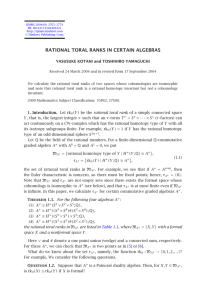

![5.5 The Haar basis is Unconditional in L [0, 1], 1 < 1](http://s2.studylib.net/store/data/010396305_1-450d5558097f626a0645448301e2bb4e-300x300.png)
